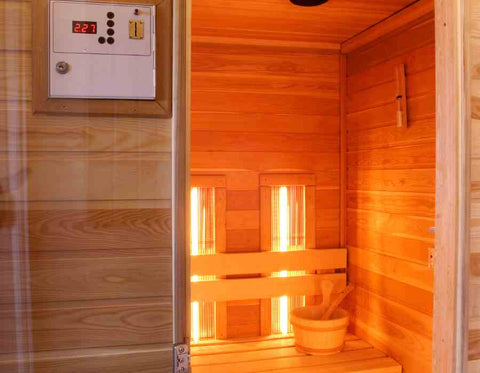How Infrared Sauna Cancer Study Is Shaping Wellness Trends
Infrared saunas, which use infrared light to generate heat that penetrates tissue directly, have become increasingly popular in recent years as part of holistic health and wellness routines. Proponents emphasize their many potential benefits. Most intriguing, preliminary research has begun to explore whether infrared sauna use may also have implications for cancer treatment and prevention.
Current research from the American Cancer Society has investigated the potential benefits of using heat therapy alongside common cancer treatments like chemotherapy and radiation. The particular type of heat application studied is known as hyperthermia therapy, which involves precise temperature elevation under medical supervision.
Although the study focused specifically on medically-administered hyperthermia (rather than self-directed sauna use), results indicated heightened efficacy of anticancer treatments when combined with heat treatments. This suggests the possibility that increasing body temperature through sauna sessions could also complement these traditional interventions.
However, additional research is still required to determine the impact of uncontrolled heating methods like traditional or infrared saunas on treatment outcomes.

What Are Infrared Saunas?
Infrared saunas are a type of sauna that use infrared light waves to create heat. Unlike traditional saunas, which heat the air around the user to induce sweating, infrared saunas directly warm the body. This direct heating method allows for deeper heat penetration at lower temperatures, making it a more comfortable experience for many users.
How Do Infrared Saunas Work?
Infrared saunas employ infrared heaters to emit infrared light, which is absorbed by the surface of the skin. This process promotes a more efficient and intense form of sweating at cellular levels, aiding in detoxification, relaxation, and potentially providing therapeutic benefits.
Traditional Saunas vs. Infrared Saunas
- Temperature: Traditional saunas operate at higher temperatures ranging from 150°F to 185°F, while infrared saunas are effective at lower temperatures, typically between 120°F and 140°F.
- Heating Method: Traditional saunas heat the air, which then warms the body. In contrast, infrared saunas directly heat the body without significantly warming the surrounding air.
- Experience and Tolerance: Due to the lower temperatures and direct heat method, many find infrared saunas to be more tolerable and comfortable, especially for extended sessions.
Potential Health Benefits
Infrared saunas are lauded for a variety of potential health benefits, including improved circulation, muscle relaxation, detoxification through sweating, and support for the immune system. Some studies also suggest benefits related to pain relief, weight loss, skin health, and the potential to treat cancer, though more research is needed to fully understand these effects.
Sauna Cancer Study: A Brief History

The use of heat for healing, known as hyperthermia therapy, has been part of medical practices for centuries.
Emergence of Sauna Cancer Research
Interest in the potential of saunas, particularly infrared saunas, to potentially aid in cancer therapy has grown with advancements in technology and a deeper understanding of cancer at the molecular level.
Initial studies focused on the role of hyperthermia in damaging and killing cancer cells, leading to a broader exploration of how sauna use might complement traditional cancer treatments.
Infrared Saunas and Hyperthermia
- Mechanism: Hyperthermia treatment involves elevating the temperature of a part of the body or the whole body to boost the immune response and make cancer cells more susceptible to treatment. Far infrared saunas offer a gentle yet effective means of inducing therapeutic hyperthermia.
- Research Focus: Early sauna cancer studies have primarily investigated the feasibility of using infrared saunas to induce hyperthermia and the subsequent effects on cancer cells, including reduced tumor growth rates and enhanced efficacy of other cancer treatments.
Current State of Research
While the field is still emerging, preliminary findings have been promising, showing potential benefits in using far infrared sauna therapy as a potential complementary treatment for cancer. These studies pave the way for more rigorous research to fully understand the mechanisms, effectiveness, and safety of infrared saunas in cancer care.
Key Findings from Infrared Sauna Cancer Studies

The exploration of infrared saunas in the context of cancer treatment and prevention has yielded intriguing results. This section delves into the significant findings from various studies, highlighting the potential benefits and mechanisms at play.
Impact on Cancer Cells and Tumor Growth
Research has indicated that the heat generated by infrared saunas can induce apoptosis, also known as programmed cell death, in certain types of cancer cells. This process is important for preventing the uncontrolled proliferation of malignant cells.
Exposure to infrared sauna heat might lead to the upregulation of heat shock proteins, contributing to the stress response in cancer cells and potentially making them more susceptible to apoptosis or enhancing their sensitivity to conventional cancer treatments.
Inhibiting Tumor Growth
Some studies suggest that regular exposure to the mild heat of an infrared sauna can slow down the growth rate of tumors. The heat stress appears to disrupt the normal function of cancer cells, making it harder for them to multiply and spread.
Improved Efficacy of Chemotherapy and Radiation
Heat therapy, including that provided by infrared saunas, has been shown to make cancer cells more susceptible to chemotherapy and radiation treatments. By weakening the cancer cells, the heat makes them less able to repair the DNA damage caused by these treatments.
Reduced Side Effects
Preliminary evidence suggests that when used in conjunction with conventional treatments, infrared sauna sessions may help alleviate some of the side effects associated with chemotherapy and radiation, such as chronic fatigue syndrome and pain.
Enhanced Immune Response
The heat from infrared sauna treatment can stimulate the immune system, increasing the production of white blood cells and those that kill cancer cells. These cells play an essential role in identifying and destroying cancer cells in the body.
Detoxification
Through profuse sweating, infrared saunas can aid in the elimination of toxins from the body. While the direct impact of this detoxification on cancer is still under investigation, it's believed to contribute to overall health and resilience.
Improved Mental and Emotional Well-being
The relaxing effect of infrared saunas can help reduce stress, anxiety, and depression, which are common among cancer patients. This improved mental and emotional state is essential for a holistic approach to cancer care.
Pain Relief and Physical Comfort
Infrared saunas have been reported to provide significant relief from pain and discomfort associated with various cancer treatments, improving patients' quality of life during their treatment journey.
Future Directions
When considering the use of a sauna when sick, especially for individuals with health conditions like cancer, caution is paramount.
While the current findings are promising, more rigorous clinical trials and long-term studies are needed to fully understand the benefits, mechanisms, and potential risks of using infrared saunas as part of cancer treatment regimens. The research community remains optimistic about the role of infrared sauna therapy in complementing traditional cancer treatments and enhancing patient care.
Related To: Infrared Sauna Benefits and Disadvantages
Infrared Saunas and Holistic Wellness Trends

The integration of infrared saunas into holistic wellness practices reflects a broader shift towards more natural and integrative approaches to health and well-being. This section explores how the findings from infrared sauna cancer studies influence wellness trends and contribute to the adoption of infrared saunas in various health and wellness contexts.
Bridging Traditional and Modern Wellness Practices
Infrared heat sauna therapy, while technologically advanced, echoes the ancient tradition of using heat for healing. This blend of old and new has appealed to those seeking natural ways to support health and wellness, leading to a resurgence of sauna use in modern wellness routines.
Integration into Holistic Health Regimens
Infrared saunas are incorporated into holistic health plans alongside other natural therapies such as yoga, meditation, and herbal supplementation. This integration is based on the premise that combining these practices can synergize their benefits, offering a comprehensive approach to health and well-being.
Personalized Wellness Experiences
Infrared saunas offer customizable settings, allowing users to tailor their experience to their specific health needs and preferences. This personalization is a key trend in the wellness industry, shifting away from one-size-fits-all solutions towards more individualized health care.
Accessibility and Home Use
Advancements in technology have made infrared saunas more accessible and affordable for home use. This democratization of sauna therapy has enabled individuals to incorporate regular sauna sessions into their personal wellness routines, contributing to the growth of the home wellness market.
Community and Social Wellness
Infrared saunas are becoming popular in community wellness centers, spas, and gyms, facilitating group sauna sessions. These communal experiences provide the potential health benefits of infrared sauna therapy and promote social connectivity and community well-being.
Educational Workshops and Retreats
Wellness retreats and educational workshops incorporate infrared sauna sessions into their programming. These events often focus on teaching participants about the several health benefits of infrared saunas, including their potential role in cancer prevention and treatment and how to integrate sauna use into a holistic wellness practice.
Supporting Mental and Emotional Health

The calming effect of infrared sauna sessions is being recognized as a valuable tool for stress management. The gentle heat helps to soothe the nervous system, reduce cortisol levels, and promote a state of relaxation, making it a sought-after therapy for managing stress and anxiety.
Enhanced Well-being and Lifestyle Balance
Regular use of infrared saunas is being promoted as part of a balanced lifestyle that prioritizes self-care and well-being. By offering a space for quiet reflection and relaxation, infrared saunas contribute to an overall sense of well-being and life satisfaction.
Safety Considerations and Best Practices
While infrared saunas offer numerous health benefits, it is essential to approach their use with an understanding of safety considerations and best practices, especially for individuals with health concerns such as cancer. This section outlines key points to ensure a safe and beneficial infrared sauna experience.
Understanding Risks and Contraindications: Medical Conditions and Sauna Use
Patients should consider how sauna heat impacts not just cancer cells but also normal cells, especially in their specific health conditions.
Cardiovascular Issues: Individuals with heart conditions should consult with a healthcare provider before using an infrared sauna, as the heat can affect heart rate and blood pressure.
Cancer Considerations: While some studies explore potential benefits for cancer patients, it's imperative to discuss sauna use with an oncologist, as certain cancer types and treatments may contraindicate heat therapy. This is especially true if their treatment or cancer progression involves specific cancer cell proteins that are sensitive to heat.
Pregnancy: Pregnant women are generally advised to avoid saunas due to the potential risks associated with overheating and dehydration.
Given the complexities of cancer science, it's imperative for patients and healthcare providers to carefully weigh the benefits and risks of infrared sauna therapy.
Medications and Heat Sensitivity
Some medications can increase sensitivity to heat or impair sweating, potentially leading to overheating. It's important for individuals on medication to consult with their doctor prior to sauna use.

Best Practices for Sauna Use
Here are the best practices on how to use a sauna:
- Before the Session: Ensure adequate hydration by drinking plenty of water before entering the sauna.
- During the Session: Listen to your body and leave the sauna if you feel dizzy or uncomfortable. Rehydrate as necessary.
- After the Session: Continue to drink water or electrolyte-replenishing beverages to replace fluids lost through sweating.
- Start Slowly: Begin your sauna therapy with shorter sessions (10-15 minutes) and gradually increase the duration as your body acclimates to the sauna heat.
- Average Sauna Temperature: While infrared saunas operate at lower temperatures than traditional saunas, it's advisable to start at the lower end of the average sauna temperature range and adjust as needed for comfort and tolerance.
Post-Sauna Cooling Down
Allow your body to cool down gradually after a sauna session. Taking a lukewarm shower can help remove sweat and toxins from the skin's surface and facilitate the body's return to its normal temperature.
Listen to Your Body and Recognize Warning Signs
Be attentive to any signals your body may send, such as lightheadedness, nausea, or excessive fatigue. These could indicate overheating or dehydration.
Post-Sauna Rest
After cooling down, take some time to rest and allow your body to recover. This rest period can further enhance the relaxation and detoxification benefits of the sauna session.
Sauna Hygiene: Personal Cleanliness
Shower before using the sauna to ensure cleanliness and after to remove sweat and toxins from the skin.
Sauna Maintenance
You need to ensure you know how to clean a sauna. Regularly clean and maintain the sauna to prevent the growth of bacteria and ensure a hygienic environment.
Special Considerations for Cancer Patients

Cancer patients should approach infrared sauna use with particular caution, keeping open communication with their healthcare team to ensure that sauna sessions are safe and potentially beneficial in the context of their overall treatment plan.
Customized guidelines based on individual health status, treatment phase, and specific medical advice are paramount for incorporating infrared sauna therapy into cancer care safely and effectively.
Can sauna therapy cure cancer?
There is no scientific evidence to suggest that sauna therapy alone can cure cancer. While some studies have explored the potential benefits of infrared sauna use in the context of cancer treatment, including stress reduction, improved well-being, and enhanced efficacy of certain therapies, it is not considered a standalone cure.
Sauna therapy may be used as a complementary treatment to support overall well-being and quality of life in cancer patients, but it should not replace conventional cancer treatments recommended by healthcare professionals.
Is it safe for cancer patients to use infrared saunas?
Safety can vary depending on the individual's specific type of cancer, treatment plan, and overall health condition. Some cancer patients may find infrared sauna sessions beneficial for relaxation and pain relief, but others, especially those with certain types of cancers or undergoing specific treatments, may be advised against it.
It is important for cancer patients to consult with their oncologist or healthcare provider before starting any new therapy, including infrared sauna use, to ensure it is safe for their particular situation.
How does sauna therapy potentially benefit cancer patients?
Potential benefits of sauna therapy for cancer patients include:
Stress Reduction: The relaxing environment of a sauna can help reduce stress levels, which is beneficial for mental and emotional health.
Pain Relief: The heat from saunas can help alleviate muscle and joint pain, which is common among cancer patients.
Improved Circulation: The heat can enhance blood circulation, which may aid in the recovery process and overall well-being.
Detoxification: Sweating induced by sauna use is often touted for its detoxifying effects, although the direct impact on cancer treatment outcomes is still under investigation. It's important to note that these benefits can vary from person to person, and more research is needed to fully understand the impact of sauna therapy on cancer patients.
Are there any specific types of cancer or treatments for which sauna use is particularly advised or contraindicated?
Sauna use may be contraindicated for patients with certain types of cancers that are sensitive to heat or for those undergoing treatments that affect the body's ability to regulate temperature or respond to heat stress.
For example, patients with skin cancers or those receiving radiation therapy to the skin may find sauna heat uncomfortable or irritating to treated areas. Certain chemotherapy agents may increase the risk of dehydration or affect the heart, making heat exposure from saunas potentially dangerous. Always consult with a healthcare provider for personalized advice.

In Summary
In exploring the role of infrared sauna therapy within cancer care, we've delved into compelling research that highlights its potential benefits, from impacting cancer cell proteins to enhancing overall well-being. While promising, it's imperative to approach this therapy with caution, especially for those undergoing cancer treatment.
The integration of infrared saunas into holistic wellness practices signals a shift towards more personalized and complementary health strategies. As this field continues to evolve, continuous dialogue among healthcare professionals, patients, and researchers is essential to fully understand and harness the benefits of infrared sauna therapy, ensuring it's a safe and effective complement to traditional cancer care.
